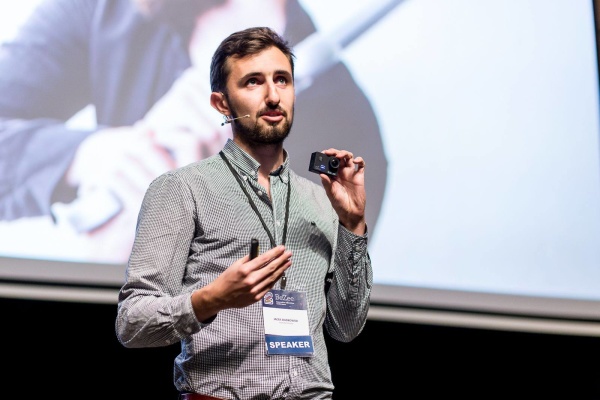
Interview: Mechanisms to Build Good Habits
Jacek Siadkowski is the founder of Gerere, a Tech for Good agency that specializes in implementing digital products with a high social impact. At Gerere, he explores the conditions conducive to long-term change through digital tools. Siadkowski also develops methods for effective project creation and implements applications for clients. He takes an agile approach to developing products and methods of building long-term commitment such as behavioural techniques, gamification and engaging online communities. He has co-created products that have changed the lives of over 50,000 people, designing for Watchdog Poland, Orange Foundation, Synapsis Foundation, Tesco and more.
Q1: Could you tell us more about Gerere?
JS: Gerere is a social enterprise that specializes in using mechanisms that help people build good habits.
Q2: What can you tell us about those mechanisms?
JS: The goal that always inspires us when designing a product is to build an environment for the person that will cause them to develop an internal motivation to positively change their behaviour.
Internal motivation is different from external motivation because external motivation is based on sending different stimuli to a person, to manipulate them into doing something. For example, these incentives could be used when our boss has promised us a bonus if we meet our targets, the stimulus can be provided by a law itself that prohibits something, or by our partner, who might expect us to look better, more attractive.
Basically the vast majority of motivation systems at work are based on external motivation. However, this external motivation is treacherous because it is easy to implement and easy to invent, but if we stop sending these stimuli, the motivation usually ceases to exist.
Internal motivation is when people do something from the feeling that… it is important for them. It might be funny, meaningful or habitual but they don’t need any stimuli to start. Unfortunately, you cannot easily motivate people intrinsically. Usually, you need to use external motivation to draw people’s attention to a task, motivate them to do a task for a few weeks, so to create neural connections, which causes the tasks to be performed automatically.
If on top of that we add a meaningful reason for desired behavior, why someone should do something and why it is important, then there is an opportunity to create lasting changes.
When designing such systems we must ensure that at the beginning the motivation system (based on external motivation) is also engaging and interesting enough to attract human attention for more than 14-21 days. At the same time, the system itself must respond to the real and important needs of the person, which will cause the external motivation to change to internal.
Q3: What kind of tools do you use? What kind of theories do you use?
JS: We use several different tools and theories to do this.
The first such theory for us is the Hooked Canvas theory, developed in the book by Nir Eyal, Hooked: How to Build Habit-Forming Products. The model comes from the Stanford Persuasive Tech Lab and it’s about creating a system that will affect people in four stages.
Firstly, once we have a person susceptible to do something, we sent them a stimulus, motivating them to get involved.
Secondly, there is a system in place that will make it easier for them to perform the desired action, the desired behaviour. In such a way that it costs as little power and energy as possible. To simply reduce the barriers to entry.
Thirdly, for each positive behaviour, they will be rewarded, preferably on a random basis, as random prizes work much more effectively than expected.
In the end it will allow the user to (as we call it) micro invest in this service in such a way that it leaves either some data, some value or promises, or a decision, which will motivate the user to return to it later.
We basically fill up this model with tools from games and fun elements because it is incredibly effective. Games are great at rewarding and nudging people. They also help to disenchant the stereotypes that people have in different areas of their lives and also helps to approach various challenges from a healthy distance.
For example, one of the most common diseases is Atrial fibrillation (also known as AFib or AF). People dealing with this are at constant risk of having a stroke or other heart-related issues but you can’t treat it with medicine. You can only prevent the consequences of this disease by maintaining a healthy lifestyle. Unfortunately, very few people manage to keep up better habits. They are sometimes too afraid to start running, exercising in general or eating healthily. If you use game mechanics, you can address this fear. You could create a tamagotchi-like game with a charming, funny heart as a main character. It would educate patients about disease and grow with exercises or changes in the diet. People would like to return to it as they remember a pleasant feeling of accomplishment and this way new neural paths are being created.
Q4: This is a great example of building new, healthier habits but what about bad habits? How easy or difficult is it to break bad habits?
JS: This is a complex subject. Did you know that scientists estimate that more than 80% of our life activities are those which we perform happen automatically without our awareness and without our conscious decision?
Seems incredible.
JS: Think about how many decisions you make during the day and think about how many things in your body happen without your consciousness.
It is all based on a very similar neuropsychological mechanism, which is based on stimulus, i.e. on some situation in the world which occurs when our brain recognizes it as known.
It has some coded way of dealing with this situation, i.e. the behaviour which we perform frequently more and more unconsciously and some reward which we receive for the fact that this behaviour took place.
The more often the behaviour repeats itself, the more our brain evokes it in an unconscious way. The more these situations take place, the more repetitive the pattern of stimulus and reaction, the more inclined we are to only do them against our conscious and responsible will.
If a company manages to create neural pathways that evoke these habits, it is very difficult to give them up because in practice our brain demands these activities and these rewards.
If we want to break with them we need to consciously limit them and learn how to not to give in to your cravings. A good method is to replace them with other actions, but with similar rewards.
Of course, if a company manages to build such a habit, then this company in the long run can benefit greatly from it. Customer addiction is the most desirable and beneficial effect of marketing and product activities that can be obtained.
Q5: How as users can we cope with that? Self-control? Or something more radical? Resign from everything?
JS: Two strategies can be used. The first is actually self-control and turning off stimuli.
It can mean turning off notifications and in extreme cases it may look like escaping to the forest and going for an offline detox.
The second strategy is to learn the mechanisms that companies apply to make people dependent on their products in order to use them. If you can recognize them, you can control them with more awareness – turn away from some products, or build healthy habits.
For example, when you learn a foreign language, this effort can give very few rewards on the way, you can either reward yourself with sweets or some other reward, or you can use Duolingo which regularly sends out various kinds of rewards or motivation to continue using the application.
Jacek Siadkowski is the founder of Gerere, a Tech for Good agency that specializes in implementing digital products with a high social impact.
Q6: Is Duolingo a good example of gamification?
JS: One of the best, we often show it as a good example.
Q7: Tell us what are the mechanisms?
JS: First of all, Duolingo divides the learning process itself into stages and gives the user a very clear and understandable message that they are making progress. That means it’s taking care of third evolutionary quest for mastery and self-fulfillment. It gives me the feeling that I am making progress and that my competences are increasing.
Secondly, of course, there are thousands of different methods of rewarding the user for making progress, i.e. going to a higher level, points for good answers and not being punished for bad ones but rather motivating to continue.
Then there are the elements that make me want to act on an ongoing basis, such as the streaks. It is based on a strong psychological effect that we are much more afraid to lose something than to gain something. It works.
Duolingo is an example of the very instrumental micro-dosing of prizes. In this case it helps people to learn but you could use it to get people hooked, whether consciously or not. A good designer should ask one key question: is it possible to use my product too much? How much time should the user spend on it?
Furthermore, how far can building habits occur in such a way to bring more benefits to the user than the unjustified attachment to activities which they do not want to perform at a given moment?
Q8: Is it about keeping the balance?
JS: Balance in this case is super difficult to even define. Firstly, one person would benefit from using the app twice a day, the other needs it only once. Secondly, how on earth can we know how much a user should use the app? People are very bad at self-evaluation. Should we take their opinion as the ultimate truth or look for an objective truth?
As an app creator we could say that you only give people a ‘hammer’ and it’s up to them to do whatever they want to do with it. Whether with the help of a hammer they will ‘build a house’ or ‘harm someone with it, is up to them.
Today we have more and more tools to face this challenge – modern analytical tools, AI-powered customization algorithms, etc. Every company should think carefully about this subject and evaluate whether their products affect people’s lives positively or negatively. What they do with this knowledge is their decision.
Q9: Do you have any last thoughts you’d like to share?
JS: For me an interesting reflection which I had recently is that there are different currencies that matter in our lives and I don’t mean money here but: time, emotions, health, good relations, attention etc.
Surprisingly, the most important of all of them is attention and it’s because attention opens the door to enjoying any other currency. So that you can concentrate while reading a book, to have good relations with other people, to not be distracted by coming back to the phone, to have energy and time whilst being mentally present.
This only proves that it is true that we live in the economy of attention. Our responsibility nowadays as people who live in this digital world is to learn and protect attention.
It is also to exert influence on the companies and organizations that do not protect and respect our attention. Finally, to learn to distinguish products that do not poison our attention, but are contributing to what’s truly important for us and our long-term plans.
Gerere tries to design products in a way that protects people’s needs. Other companies should follow this trend.
Is there anything you’d like to add? If you’re interested in sharing your experiences with us or writing a guest post for us, send us an email via hello@mudita.com!
Please feel free to get in touch via social media (send us some photos or videos too), you can find us on Facebook, Twitter and Instagram, let’s connect! To learn more about Mudita, take a look at our website and our other posts.
If you enjoyed reading this article, please share and recommend it!
Related stories

How to Combat Popcorn Brain & Boost Focus with Mindful Tech Use
Discover how 'Popcorn Brain' is depleting your attention span in our hyper-connected world and learn practical tips to combat it.

Mindful Tech Use: Digital well-being for a balanced life
Discover the art of mindful tech use with actionable tips for digital well-being.

Achieving Work-Life Balance Through Mindful Tech Use
How do you use technology to support your work-life balance and well-being?
If you'd like to receive the best stories from our blog, keep up to date with our progress and get notified about our product releases and special discounts.